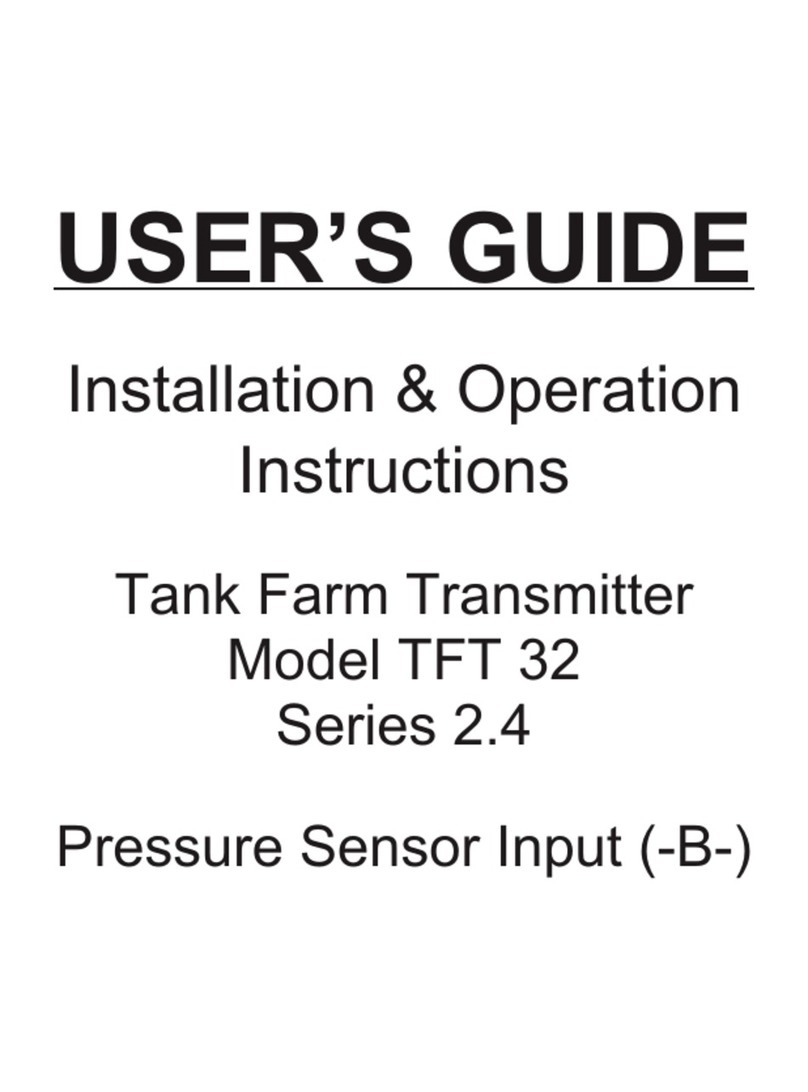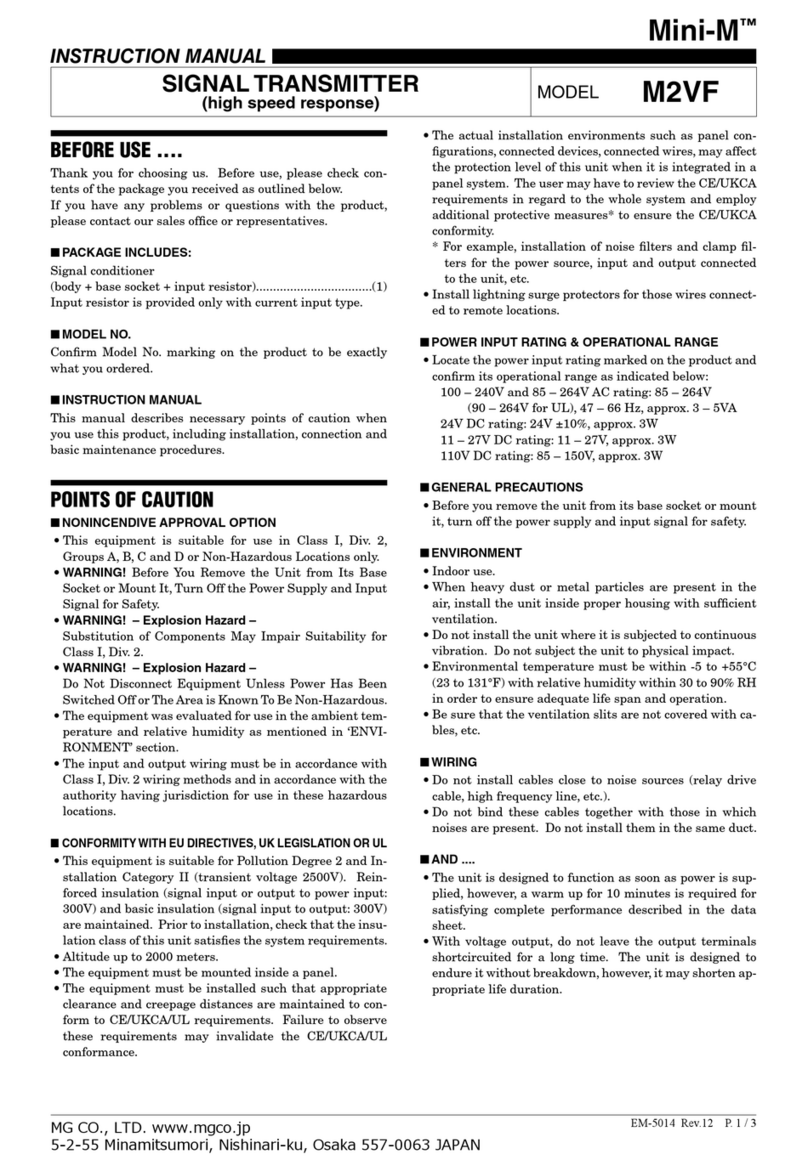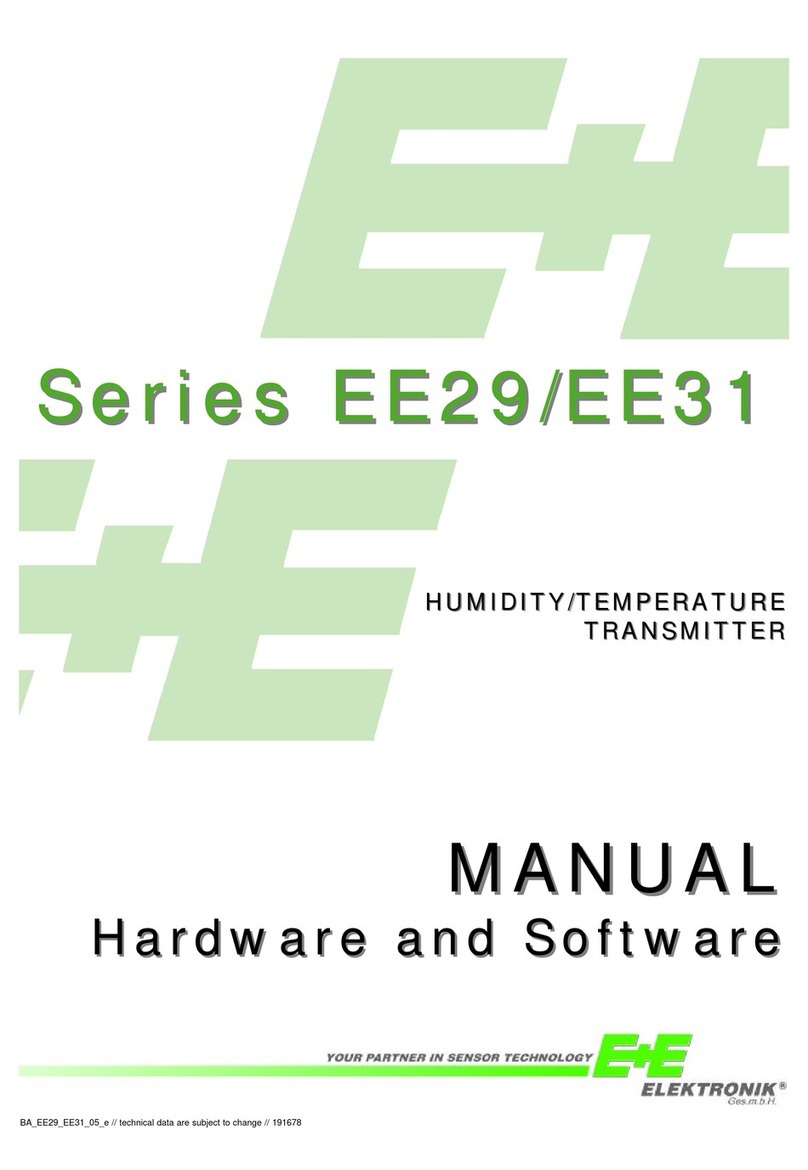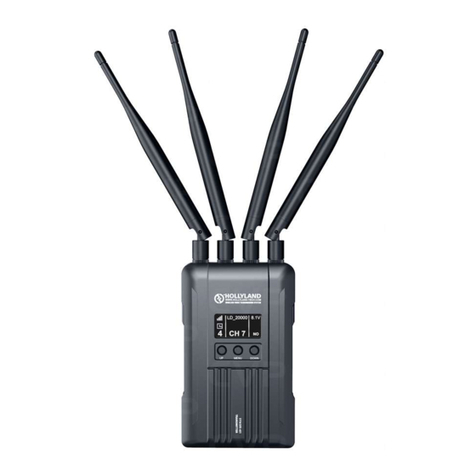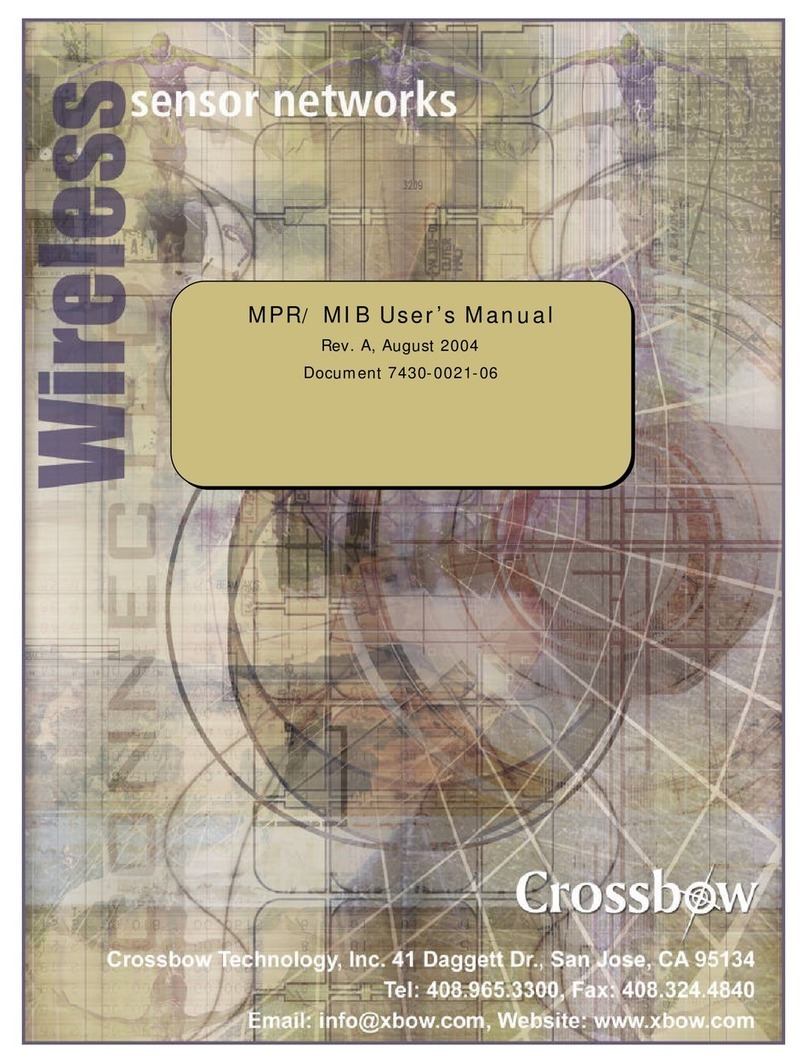Greyline Instruments LIT25 User manual

USER’S GUIDE
Installation & Operation
Instructions
Level Indicating Transmitter
Model LIT25
Manual Series 3.5.1

Note: This page has been left blank intentionally.

IMPORTANT NOTE: This instrument is manufactured and calibrated to meet product specifications.
Please read this manual carefully before installation and operation. Any unauthorized repairs or
modifications may result in a suspension of the warranty.
Available in English
Available in Adobe Acrobat pdf format
Disponible en français
Disponible en español
Page 3
LIT25 Level Indicating Transmitter
Manual Series 3.5.1
INDEX
Bench Test ······················································· 4
Connections ······················································ 4
Calibration System················································· 6
Menu ··························································· 7
Calibration Units Selection ·········································· 8
4mA Calibration ·················································· 9
Signal Relay····················································· 10
Damping························································ 11
Echo Loss Response ·············································· 11
Output Simulation ················································ 12
Store/Save Calibration ············································· 12
Temperature Indication ············································ 13
Enclosure Installation·············································· 14
Sensor Mounting ················································· 15
Error/Warning Messages ··········································· 18
Troubleshooting ·················································· 19
Applications Hotline ·············································· 22
Product Return Procedure ·········································· 23
Warranty ······················································· 24
Appendix A ····················································· 25
Appendix B ····················································· 30
Conversion Guide ················································ 31
Specifications···················································· 32

QUICK BENCH TEST:
Connect Sensor as shown below, then apply Power. When properly connected a soft clicking can be
heard from the sensor and figures will show on the LCD display. Test operation of the LIT25 by holding
the sensor steadily and aiming at a flat, stable target 12 to 28" (305 to 711 mm) away from the end of the
sensor. Allow a few seconds for the LIT25 to lock onto the target before displaying its distance. The
LIT25 will now display range in inches or cm.
Note: The LIT25 will not detect targets beyond the user entered maximum range.
CONNECTIONS:
POWER INPUT: The standard model requires AC power input between 100 to 130VAC 50/60Hz (1
amp fuse is recommended). No adjustments are necessary for any voltage in this range. Option EI rating
is 100-240VAC 50/60Hz. (See OPTIONS section of this manual for connection of optional 24VDC
power input).
IMPORTANT NOTE: To comply with CSA/NRTL standards, AC power input and relay connection
wires must have a water tight fitting conduit entry to the instrument enclosure.
Page 4
LIT25 Level Indicating Transmitter
Manual Series 3.5.1
14 AWG MAX
SENSOR
RELAY
(1 AMP)
LINE
NEUTRAL
4-20mA
+
–
IMPORTANT:
MUST CONNECT TO A
GOOD GROUND ( 1 Ohm)
WITH 14 AWG CONDUCTOR
<
CONNECT SHIELD
TO GROUND
(THIS END ONLY)
RG62AU COAXIAL
TO SENSOR
GROUND
GND
CURRENT SOURCE
DO NOT POWER LOOP

RECOMMENDED CONDUIT ENTRY
Use a screwdriver to "knock-out" conduit entry points at bottom of enclosure.
Use one entry for power input and relay wires. Use separate entry for 4-20mA and sensor cable.
Page 5
LIT25 Level Indicating Transmitter
Manual Series 3.5.1

KEYPAD SYSTEM
The LIT25 has a simple 2-key calibration system. Operating and calibration modes are shown on the
4-digit display. The keys are used to calibrate the LIT25, and to view operating mode and functions. If
the keys are not used for 10 minutes, the LIT25 will automatically go to NORMAL MODE. Except in
OUTPUT SIMULATION mode, the Relay and 4-20mA output are not affected by use of the keys until your
calibration is stored.
MENU - FLOW CHART
The following diagram shows the LIT25 Menu system. Arrows show the directions to leave a box.
Pressing a corresponding key will move to the next box in the direction shown. Numeric values are
changed by pressing and holding the Çor Èkeys.
At the bottom of the Menu is a YES? prompt. To store the calibration values permanently (even through
power failure), press the Çkey. If the Èkey is pressed from the YES? prompt no changes will be
stored and the system will return to NORMAL mode.
Page 6
LIT25 Level Indicating Transmitter
Manual Series 3.5.1
PERCENT INCHES CM
LIT25
LEVEL INDICATING TRANSMITTER
ECHO
RELAY
CALIBRATION KEYS
POWER
CONNECTION
4-DIGIT LCD DISPLAY
SENSOR
CONNECTION
4-20mA
CONNECTION
GND
+–

MENU
Page 7
LIT25 Level Indicating Transmitter
Manual Series 3.5.1
dp10
706.9
721.4
r oFF
ron
roc1
20 = 40.6
762.0
4=
123.4
CALU
638.6
CM
CM
CM
CM
LEVEL CM
PERCENT INCHES CM
RANGE CM
23c
3,5 1,2,4
TEMPERATURE
Displays Temperature at Sensor
RANGE DISPLAY
Displays Distance from Sensor to Target
(Does not affect 4-20mA output or Relay)
NORMAL MODE
CALIBRATION UNITS SELECTION
Press Çto select inches, cm or percent
4mA and 20mA CALIBRATION
Wait for the Numeric value then press ÇÈ
È
or to increase
or decrease. Value displayed is Distance from the Sensor
in inches or cm.
for Next FunctionWaitfor4=or20=andPress
RELAY SET POINTS
Wait for Numeric value and press
C).°
ÇÈand to
adjust Set Points (in Units selected, or
DAMPING (0 - 20 SECS. )
Press to AdjustÇ
RELAY OPERATION CHOICE
Press Çto select:
1 = Level Alarm
2 = Level + Echo Loss
3 = Echo Loss Only
4 = Temperature Alarm
5=Off
13
13
8
8
9
10
11
11
12
12
See Page #
YES?
-C.S-
0.0OPSL
ELC 1
CM
YES
NO
ECHO LOSS CHOICE (4-20mA OUTPUT)
Press to Select action when echo lost
1 - Hold 2 = Go to 4mA 3 = Go to 20mA
Ç
OUTPUT SIMULATION
Wait for Numeric value and press or to Increase
or Decrease Simulated Output
(Automatically returns to NORMAL mode in 10 min.).
ÇÈ
STORE YES?
Press to Store Calibration (Displays -C.S.-)Ç
Press Calibration Not StoredÈ
Sb=n
Press
equipped with an optional Intrinsic Safety Barrier for
sensor mounting in hazardous locations. This setting
compensates for the electrical characteristics of an
Intrinsic Safety Barrier.
Çto select "Y" (Yes) only when the instrument is
11

NORMAL MODE
CALIBRATION UNITS SELECTION
Press Èfrom NORMAL mode, Display will show:
LIT25 Level Indicating Transmitter
Manual Series 3.5.1
Page 8
LEVEL CM
Fl
as
h
es w
h
en goo
d
ec
h
oes
are received
ON - Relay energized
OFF - Relay de-energized
When Calibrated
for 20mA at Minimum Range
(Maximum Level)
ECHO
RELAY
When Calibrated
for 20mA at
Maximum Range
20mA =
20mA = 4mA =
4mA =
Ç
Ç
Ç
PERCENT
INCHES
CM
PERCENT INCHES CM
È
4-20mA
CALIBRATION
Echo light keeps
f
lashing
to show instrument
still operating

4mA CALIBRATION
20mA CALIBRATION
Wait for 4=and press Èto display 20 =. Now follow the same procedure to calibrate the distance from
the Sensor for 20mA output.
Remember that the LIT25 automatically reads LEVEL if 20 = is set to the minimum distance from the
sensor. Calibrate in RANGE mode by setting 20= to the maximum distance from the sensor.
Page 9
LIT25 Level Indicating Transmitter
Manual Series 3.5.1
È
20 =
È
È
È
761.9
761.8
761.7
Ç
Ç
Ç
762.1
762.2
762.3
The Display will alternate between every 3 seconds
.
MAXIMUM VALUES: 600 inches / 1524 cm
MINIMUM VALUES: 8 inches / 20.3 cm
MINIMUM SPAN (distance between 4= and 20=): 2" (5 cm)
and
RANGE
(Outage)
4mA =
20mA =
12"/30.5cm
2"/5cm
LEVEL
(Inventory)
20mA =
4mA =
12"/30.5cm
2"/5cm

SIGNAL RELAY
The LIT25 Relay is rated 1ampere, 24VDC, 120/240VAC. It includes an
internally connected noise suppressor or “snubber” with 25K ohms impedance.
Very low AC electrical loads may appear to “leak” current.
Maximum leakage is:
10mA @ 110VAC
20mA @ 220VAC
No leakage will be measured with DC electrical loads.
RELAY OPERATION CHOICE
The LIT25’s Signal Relay can be configured to operate as:
ROC1 = Level Alarm
ROC2 = Level + Echo Loss Alarm
ROC3 = Echo Loss only Alarm
ROC4 = Temperature Alarm (measured at the Sensor)
ROC5 = OFF (de-energize) at all times
Press Çto select the ROC.
RELAY CALIBRATION
ROC1 (Level Alarm)
ROC2 (Level + Echo Loss Alarm) - Relay will be energized when the Relay ON set point is
reached.
or if the echo is lost (no echoes for more than 20 seconds).
ROC4 (Temperature Alarm) - Minimum Set Point -40°C(=-40°F)
- Maximum Set Point 100°C(=212°F)
NOTE: The Set Points are displayed in the units selected at CALU. Two different Set Points (RON and
ROFF) allows a Relay “deadband” for Pump Control and to avoid Relay chatter.
Page 10
LIT25 Level Indicating Transmitter
Manual Series 3.5.1
RELAY
(1 AMP)
INTERNALLY
CONNECTED
SUPPRESSOR
Ç
Ç
Ç
ROC2
ROC3
ROC4
È
ROC = 3,5
È
È
ROC = 1,2,4
È
È
È
È
721.3
721.2
721.1
Ç
Ç
Ç
0.0
0.1
0.2
The Display will alternate between every 3 second
s
ÈÇ
and

Example of Relay Calibration
Span (Max Level) = 184 inches
RON in inches =150
ROFF in inches =30
DAMPING
Normal Setting: DP10
Fast Response (up to ½ inch /13 mm level change per
second): DP5 or less
Slow Response (turbulence) DP15 or more
NOTE: Damping Time (in seconds) is the response
time to indicate a new target. Longer Damping Times also reject false targets like agitators, splashing
etc.
INTRINSIC SAFETY BARRIER
Press Çto select "Y" (Yes) only when the instrument is equipped
with an optional Intrinsic Safety Barrier for sensor mounting in
hazardous locations. This setting compensates for the electrical
characteristics of an Intrinsic Safety Barrier.
ECHO LOSS RESPONSE
If no echoes are received for 20 seconds or longer the 4-20mA
output can be programmed to respond as follows:
ELC1 = Hold last reading
ELC2 = Output 4mA
ELC3 = Output 20mA
When one valid echo is received the LIT25 will resume normal
operation.
Page 11
LIT25 Level Indicating Transmitter
Manual Series 3.5.1
SPAN
150"
30"
20mA = 16"
4mA = 200"
RON
R OFF
SENSOR
ÈÇ
Ç
DP11
DP12
20 SECS.
MAXIMUM
ÈÇ
Ç
ELC2
ELC3
Ç
Ç
Y

OUTPUT SIMULATION MODE
The Output Simulation function controls the digital display 4-20mA output and control relay. Use it to
simplify calibration of remote 4-20mA devices such as chart recorders or remote displays, and to test
relay set-points.
Press Çand Èto simulate levels from 0% to 100% of your calibrated span. Increments will
automatically accelerate when Çor Èis continuously pressed.
TO STORE (SAVE) CALIBRATION
Press Çto Store calibration (LIT will display -C.S-).
Calibration is stored in non-volatile memory (even through power interruptions).
Press Èto return to NORMAL mode without storing any changes.
Page 12
LIT25 Level Indicating Transmitter
Manual Series 3.5.1
È
È
721.4
721.3
ÇÇ
Ç
0.1
0.2
The Display will alternate between and
È
ÈÇ
RETURN TO
NORMAL MODE
CALIBRATION
STORED

RANGE DISPLAY
From Normal Mode press Ç
Displays distance from the Sensor to Target.
Use to check measurements during calibration.
(RANGE and UNITS flash.)
Note: The LIT25 will not detect targets beyond the user entered maximum range.
TEMPERATURE DISPLAY
Displays temperature in degrees Centigrade
measured at the Sensor.
TEMPERATURE LOG
Displays maximum temperature in degrees
Centigrade measured at the Sensor.
From normal Temperature display, press and hold Èthen Ç.
Page 13
LIT25 Level Indicating Transmitter
Manual Series 3.5.1
Ç
RANGE CM
RETURN TO
NORMAL MODE
RETURN TO
NORMAL MODE

ENCLOSURE INSTALLATION
Locate the enclosure within 500 ft (150 m) of the sensor. It can be wall mounted with four mounting
screws (supplied) or panel mounted with Option PM Panel Mounting Kit from Greyline Instruments.
Avoid mounting the enclosure in direct sunlight to protect the electronics from damage due to
overheating and condensation. Seal conduit entries to prevent moisture from entering enclosure.
NEMA4X (IP66) WITH CLEAR COVER
1. Remove enclosure cover.
2. Insert #6 screws through the four enclosure mounting holes
to secure enclosure to wall or mounting stand.
3. Replace Cover
An additional conduit hole can be cut in the end of the enclosure
if required. Use a screwdriver to "knock out" additional holes.
Note:
1. This non-metallic enclosure does not automatically provide grounding between conduit connections.
Grounding must be provided as part of the installation. Ground in accordance with the requirements of
the National Electrical Code. System grounding is provided by connecting grounding wires from all
conduit entries to the steel mounting plate or another point which provides continuity.
2. Water tight “O” ring seals must be used if cable strain-reliefs are used.
Page 14
LIT25 Level Indicating Transmitter
Manual Series 3.5.1
END VIEW
ENCLOSURE
MOUNTING
HOLES
ENCLOSURE
COVER

SENSOR MOUNTING LOCATION
SENSOR MOUNTING
Each sensor is equipped with a ¾ inch “isolation coupling” which MUST be used in your installation. A
threaded nipple or length of conduit may be used to position the sensor at the desired height.
The sensor should be hand-tightened (like a light bulb) by turning the sensor stem only. DO NOT use a
wrench and do not over tighten. DO NOT clamp the sensor below the isolation coupling.
The standard PZ32T Sensor must be mounted 12" / 30.48 cm or more above the maximum liquid level.
(Optional PZ12 sensor must be 8" / 20.3 cm above maximum level and optional PZ52T sensor must be
16" / 406 mm above maximum level.)
Page 15
LIT25 Level Indicating Transmitter
Manual Series 3.5.1
1 FT HORIZONTAL
FROM SIDEWALL FOR
EVERY 10 FT VERTICAL
NOTE: 2 FT FOR EVERY
10 FT DEPTH ON
APPLICATIONS WITH
ROUGH SIDEWALLS,
LADDERS,
REINFORCING RINGS
ETC.
PREFERRED SENSOR
LOCATION
6" SCHEDULE 40
PIPE IF EXTENSION
REQUIRED
SENSOR FACE MUST
BE HORIZONTAL ±1°
MAX. LIQUID LEVEL

SENSOR MOUNTING
Page 16
LIT25 Level Indicating Transmitter
Manual Series 3.5.1
4" OR 6" BLIND FLANGE
TAPPED ¾" NPT
FLEXIBLE
CONDUIT
JUNCTION
BOX
(OPTION JB)
ISOLATION
COUPLING
(SUPPLIED)
MUST BE
USED
DO NOT
CLAMP IN
THIS AREA
¾" NPT
NIPPLE
FLANGE MOUNT
ISOLATION
COUPLING
(SUPPLIED)
MUST BE
USED
DO NOT
CLAMP IN
THIS AREA
CLAMP
3/4"
CONDUIT
CROSS BAR MOUNT
ISOLATION
COUPLING
(SUPPLIED)
MUST BE
USED
DO NOT
CLAMP IN
THIS AREA
3/4" NPT
NIPPLE
ANGLE MOUNT
ISOLATION
COUPLING
(SUPPLIED)
MUST BE
USED
DO NOT
CLAMP IN
THIS AREA
3/4"
CONDUIT
CONDUIT MOUNT
Notes:
1. Use the ¾" NPT "Isolation Coupling"
supplied and only. Do
not clamp sensor body or stem.
2. Locate the sensor 1 ft (30 cm) from
the sidewall or obstruction for every
10 ft (3 m) depth.
3. mount in direct sunlight.
4. Extend sensor cable up to 500 ft
(150 m) with RG62AU coaxial only.
hand tighten
Do not
GRIND OR FILE
PIPE EDGE
SMOOTH
STAND PIPE MOUNT
STANDPIPE LENGTH
AS SHORT AS POSSIBLE
STANDPIPE DIAMETER
AS LARGE AS POSSIBLE
TYPICAL STANDPIPE:
4” / 100 mm DIAMETER
12” / 300 mm LENGTH
NARROW DIAMETER
STANDPIPES (<4” / 100 mm)
MAY AFFECT ACCURACY
OF READING

SENSOR MOUNTING/LOCATION
- Tank Level/Inventory Applications
Each LIT25 Level Transmitter includes a
non-contacting ultrasonic sensor. The sensor must be
installed in a position to obtain unobstructed echoes
from the liquid or material being measured.
Mount the sensor away from pipes, ladders, or
structural members which might cause continuous false
echoes.
Page 17
LIT25 Level Indicating Transmitter
Manual Series 3.5.1
SENSOR MOUNTED
AWAY FROM MATERIAL
PATH. COARSE SOLIDS
WILL USUALLY RETURN
AN ECHO EVEN IF AT
AN ANGLE
FINE POWDERS
MAY NEED SENSOR
TILTED NORMAL TO
SURFACE TO OBTAIN
GOOD ECHOES
SOLIDS AND POWDERS
90°
BAD GOOD

ERROR/WARNING MESSAGES
Page 18
LIT25 Level Indicating Transmitter
Manual Series 3.5.1
Instrument has detected Sensor connections/cable open.
Instrument has detected Sensor connections/cable short.
No valid echoes for 10 seconds.
No valid echoes for 20 seconds. See Troubleshooting (F).
Illegal Span. Distance between 20 = and 4 = must be
greater than 2" (5 cm)
Indicates that the target is above the
calibrated maximum level (too close to
the Sensor).
Indicates target is further than the calibrated Maximum Range.
Indicates that the LIT25 has experienced electrical interference strong enough to corrupt
the memory. The LIT25 must be reset and recalibrated.
: Reset will clear all memory. LIT25 will need recalibration after this
procedure: Press and hold
Reset Procedure 1
and until the LIT25 displays----.ÇÈ
XXAlways displayed at power-up (x.x indicates Software version).
Otherwise indicates instrument has reset automaticall
y
. See Troubleshootin
g
(C,D,E).

FIELD TROUBLESHOOTING
SYMPTOMS CHECK
Level Display - full scale
- zero
- erratic - random
- higher than actual
- fluctuating
A
B
C
D
E
ECHO LOSS prompt - flashing F
Calibration Non-Linear H
EEEE - memory corruption I
SYMPTOMS FAULTS SOLUTIONS
Unit “See’s Wrong Target Due To:
A - sensor cover not removed - remove protective cover after
installation
A,C,D,F - sensor not aimed correctly
A,D,F - dust/dirt buildup on sensor - clean carefully (do not scratch sensor
face)
A,D,F - condensation on sensor - lower sensor
- insulate sensor mounting location
- wipe sensor face and body with Rain-X
A,D - sensor mounting stand pipe
- too long/ - too narrow
-dirty/ - gasket intruding
- lower Sensor below stand pipe intrusion
D,E -agitator, strong turbulence -increase Damping
C-material filling through sensor beam -increase Damping
Unit Picks-Up Acoustic Interference Due To:
A,C -noise from high pressure fill -install submerged fill pipe
A,D -sensor coupling over tightened -hand tighten only (like a light bulb)
A,D -sensor coupling not used -use isolation coupling supplied
C-other ultrasonic sensor in close
proximity
-separate Sensors
Electrical Interference:
C-sensor cable connections reversed
C,D -through Sensor cable -use properly grounded metal conduit
C-sensor cable and/or junction not
insulated
-use metal Junction Box
C,D -through 4-20mA output cable -use shield twisted pair (shield to AC
ground)
Page 19
LIT25 Level Indicating Transmitter
Manual Series 3.5.1

SYMPTOMS FAULTS SOLUTIONS
C,D -wiring or installation close to
variable speed drive or inverter
-follow VSD manufacturer’s instructions
for Drive grounding wiring and
shielding
C,D,E -AC/Chassis Ground missing on
instrument power connections
-install adequate Ground
I-relay sparking produces EMI
interference
-use snubber across Relay contacts
(option SNUB)
-do not exceed 1 ampere load
I-instrument installed in the same
panel with high voltage/large motor
controls
-relocate or use metal enclosure
Wiring Problems Due to Sensor Cable:
C,F - open circuit - check connections/continuity (8850 to
12700 ohms max./-30°C to +70°C )
F - short circuit - check connections/continuity (8850
ohms min.)
F - too long (max. 500 ft, 150 m)
C - bundled/run in conduit with power
cable
C - sensor ground shorted to
conduit/enclosure
- insulate
A - extended with wrong type of wire - use only RG62AU coaxial
C - close to high voltage/large motors
Non-Linearity Due To:
H - vapour -calibrate in-situ
B,H - zero not set accurately -recalibrate
H - full scale not set accurately -Note: Minimum Range must be ≥12”
(30.5cm)
Page 20
LIT25 Level Indicating Transmitter
Manual Series 3.5.1
Table of contents
Other Greyline Instruments Transmitter manuals
Popular Transmitter manuals by other brands
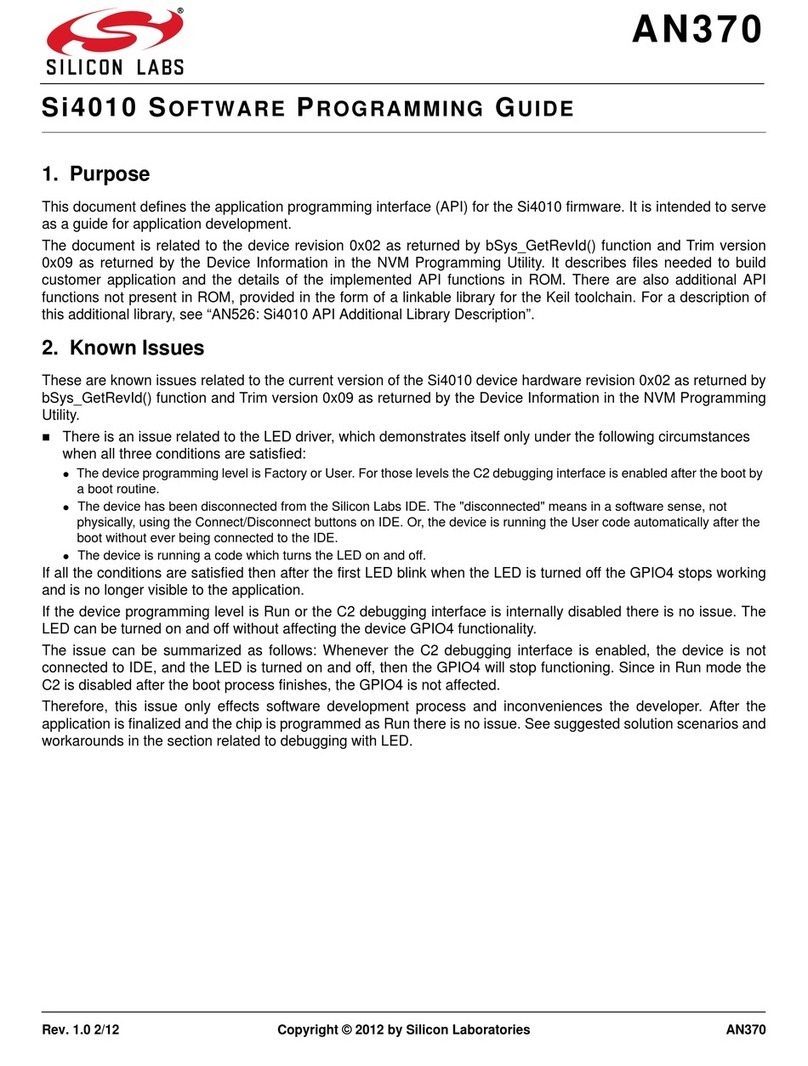
Silicon Laboratories
Silicon Laboratories Si4010 Series Software Programming Guide

AMP
AMP EST1 quick start guide

Belkin
Belkin F8Z618cw user manual
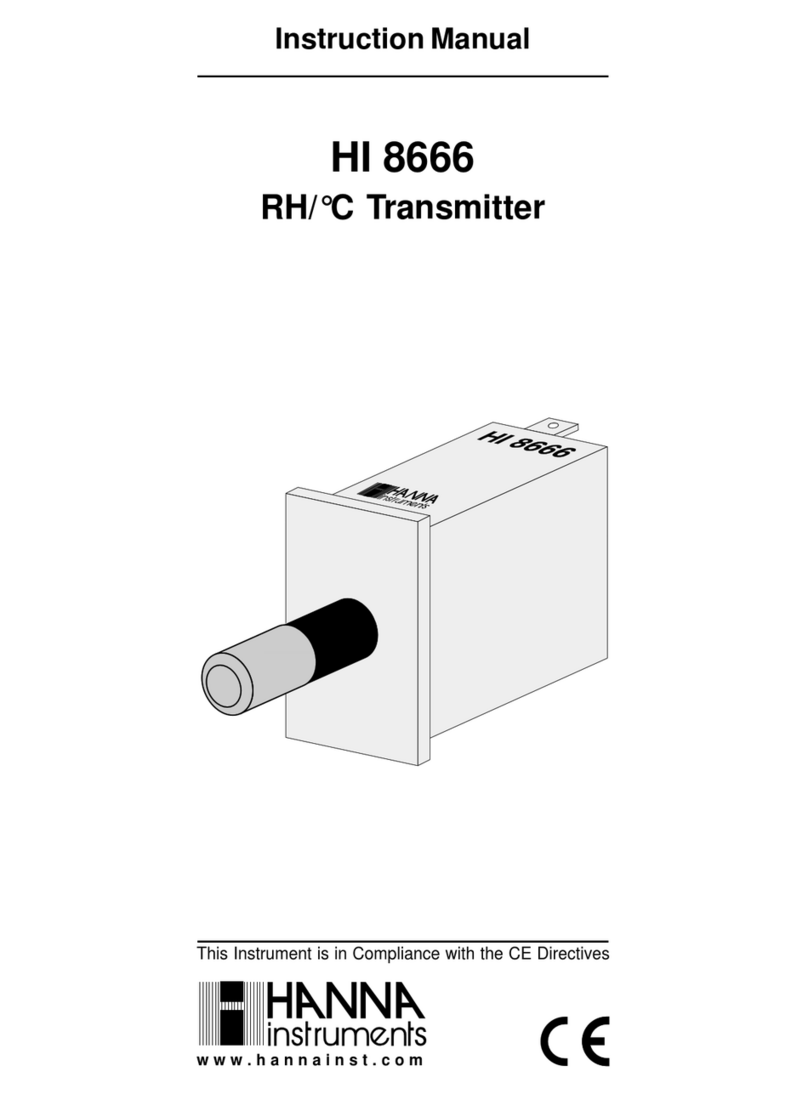
Hanna Instruments
Hanna Instruments HI 8666 instruction manual

Micro Motion
Micro Motion Fisher-Rosemount RFT9709 instruction manual
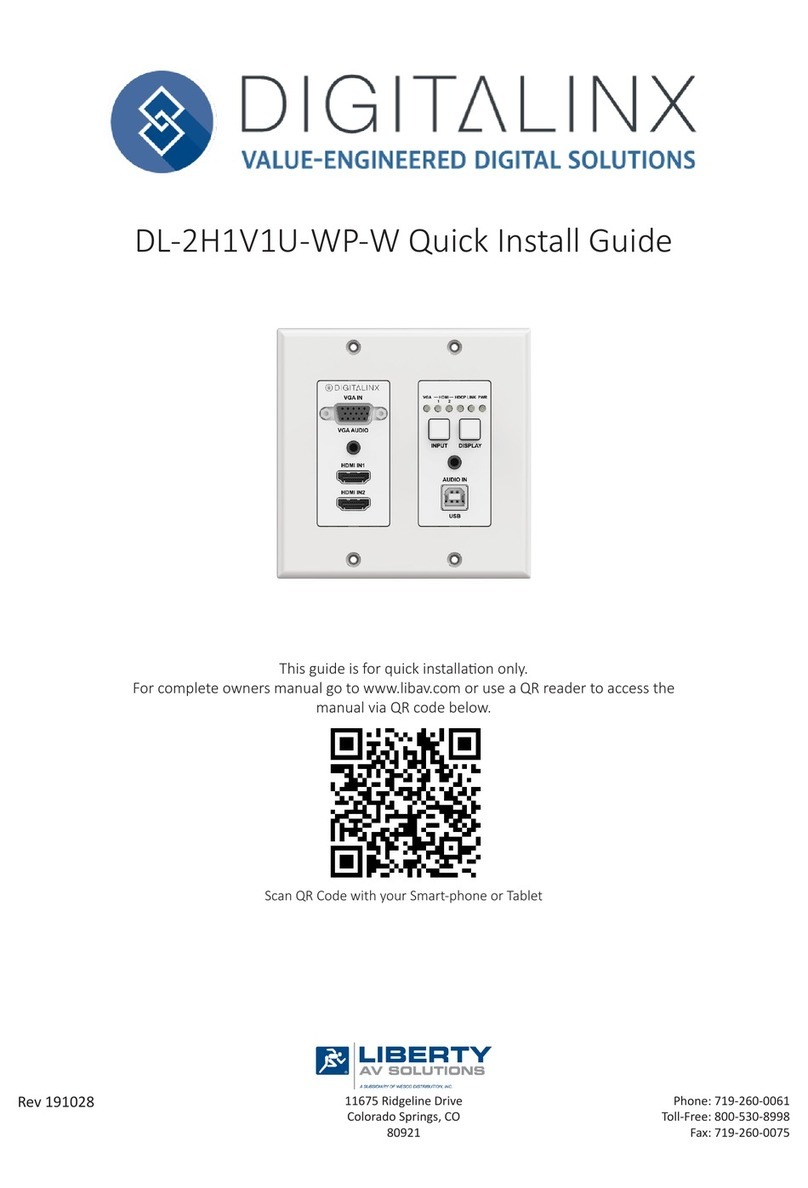
DigitaLinx
DigitaLinx DL-2H1V1U-WP-W Quick install guide

St. Jude Medical
St. Jude Medical Merlin@home EX1150 quick start guide

Emerson
Emerson Rosemount 8750W Reference manual
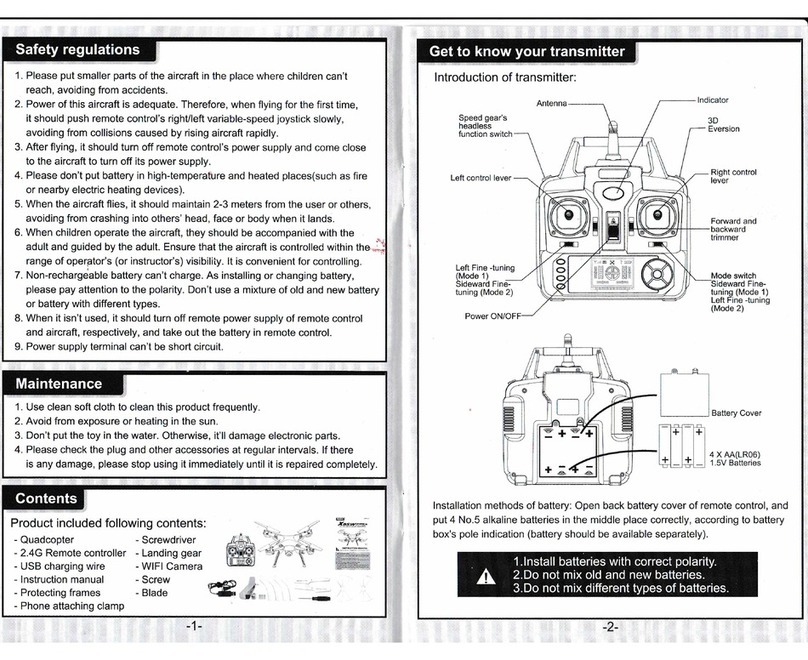
Helipal
Helipal Syma X5SW user manual

Teledyne
Teledyne LXT-230 Installation and operating manual
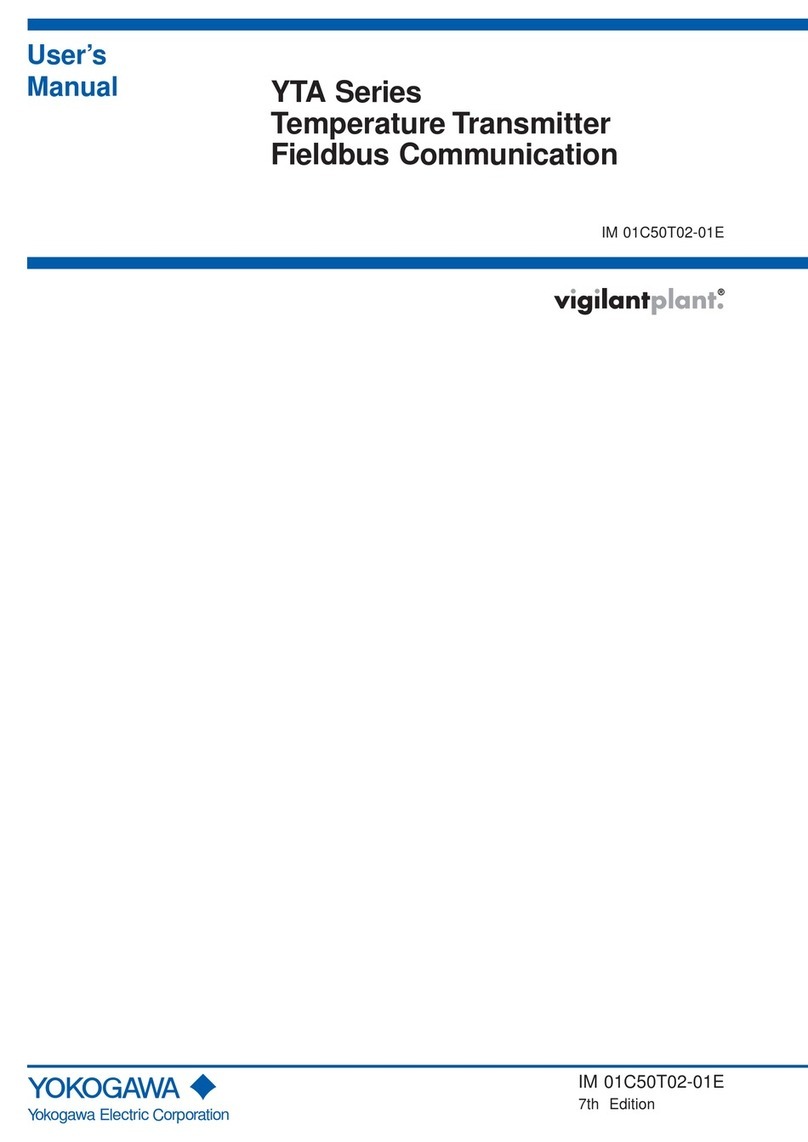
YOKOGAWA
YOKOGAWA vigilantplant YTA Series user manual
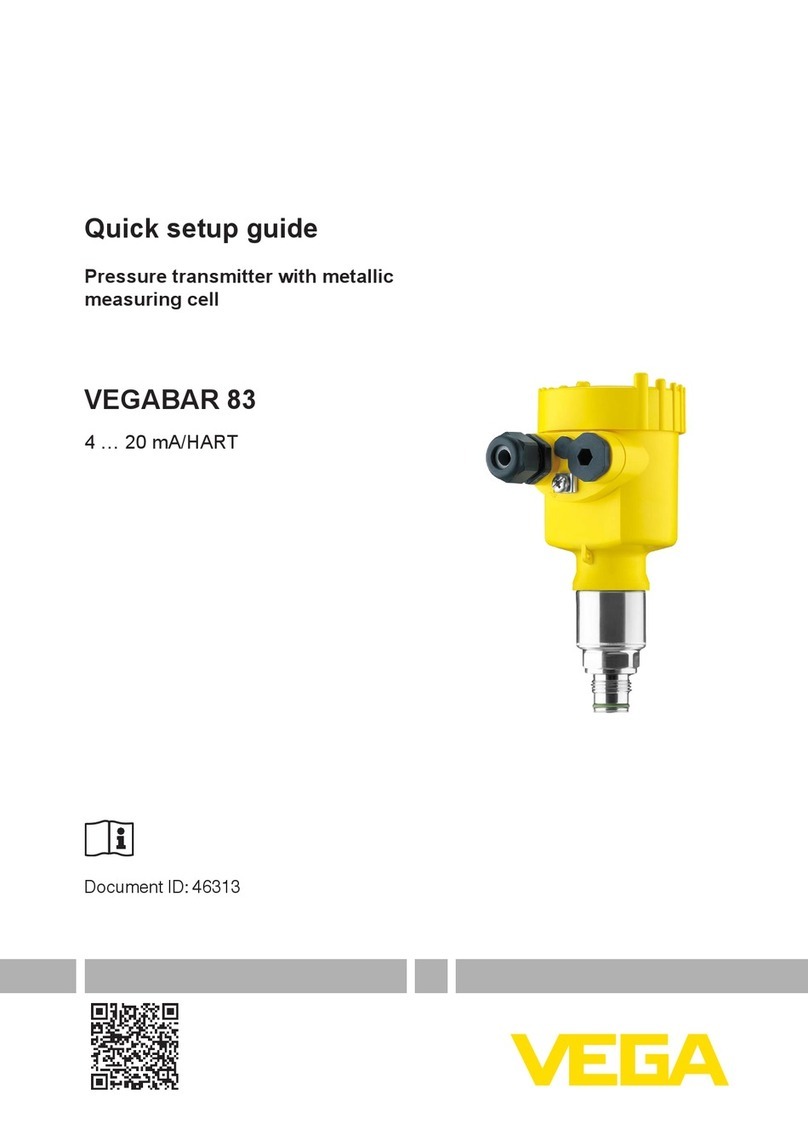
Vega
Vega VEGABAR 83 Quick setup guide
